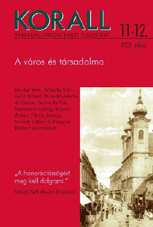A szegények és a betegek gondozása a középkor végi magyar városokban
The Assistance to the Poor and the Sick in the Late Medieval Hungarian Towns
Author(s): Marie-Madeleine De CevinsSubject(s): History
Published by: KORALL Társadalomtörténeti Egyesület
Keywords: social history; urban history; Late Medieval Ages; 14-15th centuries; Hungary; towns; church; charity; hospital; health; poor people
Summary/Abstract: The main purpose of this study is to determine whether the hospices and other charitable institutions of the kingdom of Hungary were numerous and active enough to insure the assistance to the poor and the sick at the end of the Middle Ages (i.e. during the fourteenth and fifteenth centuries). The author also tries to stress the originality of the Hungarian charity system. The description of the different kinds of hospices existing in Hungary at that time (hospitale, xenodochium, otherwise spittal, sichhaus, krankenhaus in the German sources) shows that all of them depended on Church, particularly on the secular clergy (bishops, canons, parish priests), though monasteries of ancient and military orders still had charitable activities. Often dedicated to the Holy Spirit or to Saint Elizabeth, the Hungarian hospices appeared mostly during the second half of the fourteenth century. Nevertheless, even at the end of the fifteenth century, there were only one or two hospitals in most of the Hungarian towns, caring for something like 4000 people! Perhaps because the number of poor people and victims of plague epidemics (like the Black Death) were proportionately lower in Hungary, than in France, England or Germany in this period... But other institutions could also provide help to the poor, like the confraternities, increasingly numerous from the middle of the fifteenth century. In their last wills, the most wealthy citizens always gave sums of money to the poor of the town. The two famous Franciscan preachers of Hungary at the end of the fifteenth century, Pelbart of Temesvar and Osvald of Lasko, emphasized in their sermons the importance of the gifts towards the poor in working out one’s own salvation. The Hungarian hospices were rather small: they could receive only about twelve persons at the same time, rarely more than twenty. Most of their hosts were poor, but not necessary sick. So the main tasks of the staff of these institutions were to give them a roof, some food, possibly clothes... Besides, they provided some spiritual support too: while living in them, people could attend mass and receive confession and Holy Sacrament in the church of the hospital. At the end of the fifteenth century – that is very late in comparison with French, German or English towns –, the urban municipalities of the Hungarian towns began to take the hospitals under control, at least for the administration of their goods and incomes, and sometimes also for the nomination of their rector. The lay hospices appeared mostly in the first decades of the sixteenth century, showing both the strong increase of the number of indigents and the entering in a new age: the modern period.
Journal: Korall - Társadalomtörténeti folyóirat
- Issue Year: 2003
- Issue No: 11-12
- Page Range: 47-74
- Page Count: 28
- Language: Hungarian

